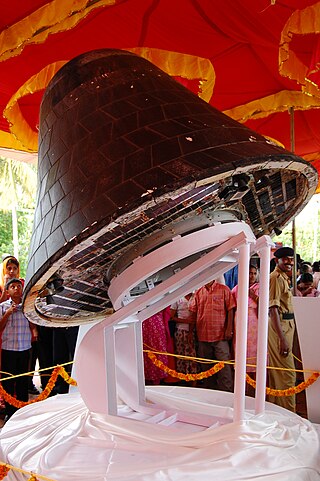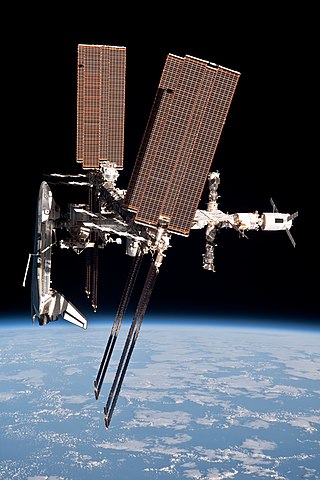| Start Date/Time | Duration | End Time | Spacecraft | Crew | Function | Remarks |
|---|
14 January
20:59 | 6 hours
3 minutes | 15 January
03:02 | Expedition 4
ISS Pirs |  Yuri Onufriyenko Yuri Onufriyenko
 Carl E. Walz Carl E. Walz | Moved the cargo boom for the Russian Strela crane from PMA-1 to the exterior of Pirs, installed an amateur radio antenna onto the end of Zvezda. [17] | |
25 January
15:19 | 5 hours
59 minutes | 21:18 | Expedition 4
ISS Pirs |  Yuri Onufriyenko Yuri Onufriyenko
 Daniel W. Bursch Daniel W. Bursch | Installed six deflector shields for Zvezda's jet thrusters, installed a second amateur radio antenna, attached four science experiments, and retrieved and replaced a device to measure material from the thrusters. [17] | |
20 February
11:38 | 5 hours
47 minutes | 17:25 | Expedition 4
ISS Quest |  Carl E. Walz Carl E. Walz
 Daniel W. Bursch Daniel W. Bursch | Tested the Quest airlock, and prepared it for the four spacewalks that will be performed during STS-110. [17] | First Quest-based EVA without a Space Shuttle at the station. |
4 March
06:37 | 7 hours
1 minute | 13:38 | STS-109
Columbia |  John M. Grunsfeld John M. Grunsfeld
 Richard M. Linnehan Richard M. Linnehan | Removed the starboard solar array and replaced it with a new, smaller and more powerful third generation solar array. The old array was stowed in the payload bay for return to Earth. [18] | Hubble Space Telescope servicing |
5 March
06:40 | 7 hours
16 minutes | 13:56 | STS-109
Columbia |  James H. Newman James H. Newman
 Michael J. Massimino Michael J. Massimino | Removed the port solar array and replaced it with a new third generation solar array. The old array was stowed in the payload bay for return to Earth. Removed and replaced the Reaction Wheel Assembly (RWA). [19] | Hubble Space Telescope servicing |
6 March
08:28 | 6 hours
48 minutes | 15:16 | STS-109
Columbia |  John M. Grunsfeld John M. Grunsfeld
 Richard M. Linnehan Richard M. Linnehan | The spacewalk was delayed 2 hours by a leak in Grunsfeld's spacesuit. The Power Control Unit (PCU) was removed and stowed for return to Earth. A new, more powerful PCU, sized to match the more productive solar arrays, was installed. [20] | Hubble Space Telescope servicing |
7 March
09:00 | 7 hours
30 minutes | 16:30 | STS-109
Columbia |  James H. Newman James H. Newman
 Michael J. Massimino Michael J. Massimino | Removed the Faint Object Camera from the aft shroud and installed the Advanced Camera for Surveys in the same location. After stowing the Faint Object Camera in the payload bay for return to Earth, the Electronic Support Module was installed in the aft shroud. [21] | Hubble Space Telescope servicing |
8 March
08:46 | 7 hours
20 minutes | 16:06 | STS-109
Columbia |  John M. Grunsfeld John M. Grunsfeld
 Richard M. Linnehan Richard M. Linnehan | Installed an experimental Cryocooler for NICMOS inside the aft shroud of and connected it to the Electronic Support Module installed the day before. Installed the Cooling System Radiator and connected it to the NICMOS. [22] | Hubble Space Telescope servicing |
11 April
14:36 | 7 hours
48 minutes | 22:24 | STS-110
ISS Quest |  Steven Smith Steven Smith
 Rex J. Walheim Rex J. Walheim | Began installing the S0 Truss onto Destiny, initial power and data connections installed between the station and S0, and installed two forward struts that permanently hold the truss in place. [23] | |
13 April
14:09 | 7 hours
30 minutes | 21:39 | STS-110
ISS Quest |  Jerry L. Ross Jerry L. Ross
 Lee M.E. Morin Lee M.E. Morin | Continued S0 Truss installation, power and data cable connections installed between S0 and the station, and installed two aft struts that permanently hold the truss in place. [23] | |
14 April
13:48 | 6 hours
27 minutes | 20:15 | STS-110
ISS Quest |  Steven Smith Steven Smith
 Rex J. Walheim Rex J. Walheim | Released the claw that was used in the initial attachment of the S0 Truss, installed connectors that will be used to route power to Canadarm2 when it is on the truss, released launch restraints from the Mobile Transporter, and removed a small thermal cover the Mobile Transporter's radiator. [23] | |
16 April
14:29 | 6 hours
37 minutes | 21:06 | STS-110
ISS Quest |  Jerry L. Ross Jerry L. Ross
 Lee M.E. Morin Lee M.E. Morin | Pivoted the "Airlock Spur", which will be used by spacewalkers in the future as a path from the airlock to the truss, installed handrails onto S0, partially assembled a platform, and installed two floodlights. [23] [24] | |
9 June
15:27 | 7 hours
14 minutes | 22:41 | STS-111
ISS Quest |  Franklin Chang-Diaz Franklin Chang-Diaz
 Philippe Perrin Philippe Perrin | Attached a Power Data Grapple Fixture to the P6 truss, removed debris panels from the payload bay and attached them to a temporary location on PMA-1, and removed thermal blankets to prepare the Mobile Base System for installation onto the station's Mobile Transporter. [25] [26] | |
11 June
15:20 | 5 hours | 20:20 | STS-111
ISS Quest |  Franklin Chang-Diaz Franklin Chang-Diaz
 Philippe Perrin Philippe Perrin | Attached Mobile Base System to the Mobile Transporter, attached power, data and video cables from the station to the MBS. [25] [27] | |
13 June
15:16 | 7 hours
17 minutes | 22:33 | STS-111
ISS Quest |  Franklin Chang-Diaz Franklin Chang-Diaz
 Philippe Perrin Philippe Perrin | Replaced Canadarm2's wrist roll joint, and stowed the old joint in the shuttle's payload bay to be returned to Earth. [25] [28] | |
16 August
09:25 | 4 hours
23 minutes | 13:48 | Expedition 5
ISS Pirs |  Valery Korzun Valery Korzun
 Peggy Whitson Peggy Whitson | Installed six micro meteoroid debris panels onto Zvezda. [29] | Whitson became the 6th American and the 7th female spacewalker. |
26 August
05:27 | 5 hours
21 minutes | 10:48 | Expedition 5
ISS Pirs |  Valery Korzun Valery Korzun
 Sergei Treshchyov Sergei Treshchyov | Installed a frame on the outside of Zarya for spacewalk assembly tasks, installed new samples on a pair of Japanese Space Agency experiments housed on Zvezda, installed devices on Zvezda that would simplify the routing of tethers during future spacewalks, and installed two additional ham radio antennas on Zvezda. [29] | |
10 October
15:21 | 7 hours
1 minute | 20:35 | STS-112
ISS Quest |  David Wolf David Wolf
 / /  Piers Sellers Piers Sellers | Released launch locks that held the S1 truss radiators in place during launch, attached power, data and fluid lines between the S1 truss and S0, deployed the station's second S-Band communications system, installed the first of two external camera systems, and released launch restraints on the truss' mobile spacewalk workstation, Crew and Equipment Translation Aid (CETA). [30] [31] | |
12 October
14:31 | 6 hours
4 minutes | 20:35 | STS-112
ISS Quest |  David Wolf David Wolf
 / /  Piers Sellers Piers Sellers | Installed a second camera system, released more radiator launch locks, removed insulation covers on quick-disconnect fittings near the Z1 and P6 junction and to install Spool Positioning Devices, released starboard-side launch restraints on the CETA cart, and attached Ammonia Tank Assembly cables. [30] [32] | |
14 October
14:08 | 6 hours
36 minutes | 20:44 | STS-112
ISS Quest |  David Wolf David Wolf
 / /  Piers Sellers Piers Sellers | Removed and replaced the Interface Umbilical Assembly on the station's Mobile Transporter, installed two jumpers that will allow ammonia coolant to flow between the S1 and S0 Trusses, released a drag link and stowed it, and installed Spool Positioning Devices (SPD) on ammonia lines. [30] [33] | |
26 November
19:49 | 6 hours
45 minutes | 27 November
02:34 | STS-113
ISS Quest |  Michael Lopez-Alegria Michael Lopez-Alegria
 John Herrington John Herrington | Initial installation of the P1 truss, installed connections between the P1 and the S0 truss, released launch restraints on the CETA cart, installed Spool Positioning Devices (SPDs) onto the station, removed a drag link on P1 that served as a launch restraint, and installed a Wireless video system External Transceiver Assembly onto the Unity node. [34] [35] | |
28 November
18:36 | 6 hours
10 minutes | 29 November
00:46 | STS-113
ISS Quest |  Michael Lopez-Alegria Michael Lopez-Alegria
 John Herrington John Herrington | nstalled fluid jumpers where the S0 and the P1 are attached to each other, removed the P1's starboard keel pin, installed another Wireless video system External Transceiver Assembly onto the P1, and relocated the CETA cart from the P1 to the S1 truss. [34] [36] | |
30 November
19:25 | 7 hours | 1 December
02:25 | STS-113
ISS Quest |  Michael Lopez-Alegria Michael Lopez-Alegria
 John Herrington John Herrington | Installed more Spool Positioning Devices, reconfigured electrical harnesses that route power through the Main Bus Switching Units, and attached Ammonia Tank Assembly lines. [34] [37] | |

















